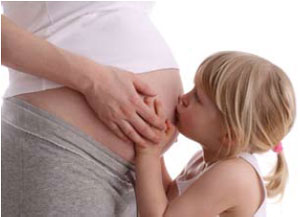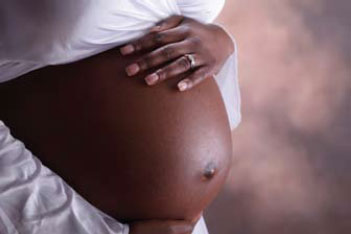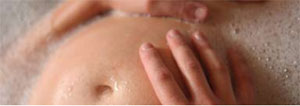Labour and birth—warm water immersion and water birth
Mater Mothers’ Hospitals (South Brisbane) support women’s personal preferences. We acknowledge that you may choose warm water immersion in labour to help promote and facilitate normal birth and to birth your baby underwater.
Nine birthing rooms are available with baths for warm water immersion, two rooms have birthing pools and there is one inflatable birthing pool that can be made available in any of the birthing rooms if required.
Why is the water temperature important?
During water immersion (first stage labour) the midwife will adjust the temperature of the bath/pool to your comfort. However, it is important that you do not overheat, so your temperature will be taken regularly – if it becomes elevated, the midwife will ask you to leave the bath/pool to cool down and may adjust the water temperature by adding cold water. It is also very important to drink plenty of water while you are in the bath/pool to remain well hydrated.
During water birth (second stage labour) it is important the water temperature is similar to your body temperature (37–37.5 degrees Celsius), so that your baby has a smooth transition from being in-utero to being born underwater (this consistent temperature avoids stimulating your baby’s gasp reflex). The midwife will monitor the water temperature every 15 minutes and adjust it as needed.
What is water immersion?
If you are well, your pregnancy has been uncomplicated, you weigh less than 110 kg, and you have progressed to 37 completed weeks of pregnancy, you may wish to consider water immersion.
What are the benefits of warm water immersion during labour?
 Warm water immersion can be very effective for comfort and pain relief during labour. Water provides support and buoyancy that enables labouring women to relax and take advantage of the weightless feeling it provides.
Warm water immersion can be very effective for comfort and pain relief during labour. Water provides support and buoyancy that enables labouring women to relax and take advantage of the weightless feeling it provides.
Warm water immersion in labour can diminish stress hormones (catecholamines) and reduce pain by increasing the body’s production of pain relievers (endorphins). It can ease muscular tension and help you to relax between contractions.
Labouring in water may:
- provide significant pain relief
- reduce the need for drugs and interventions, particularly epidurals
- encourage a sense of control in labour and increase satisfaction
- provide a feeling of weightlessness—relieving tired muscles and stress
- speed up labour
- promote relaxation and conserve energy.
Water immersion in labour is not associated with longer labour, increased operative deliveries or poor neonatal outcomes.
When should I get in the bath?
 Wait until you are in established labour, which means that you’re having regular contractions (about every five minutes) and they are lasting about one minute, before you get into the warm water. Sometimes, if you are in very early labour, the water can be so relaxing that labour slows down.
Wait until you are in established labour, which means that you’re having regular contractions (about every five minutes) and they are lasting about one minute, before you get into the warm water. Sometimes, if you are in very early labour, the water can be so relaxing that labour slows down.
For women in established labour, warm water has been found to promote relaxation which may enhance your oxytocin levels and help labour progress. It is a good idea to talk with your doctor or midwife when you are in labour about the appropriate time to consider getting into the water.
When should I get out of the bath?
While most normal labour progresses without problems, birth can be unpredictable for both mother and baby. Your midwife or doctor may ask you to leave the bath because they have identified a problem which they need to investigate with you out of the bath. You will be encouraged to leave the bath every two hours for a short time to walk around and use the bathroom.
Are there any restrictions to warm water immersion in labour?
 You may be unable to choose warm water immersion in labour if it has been identified as a risk to either you or your baby. It may not be safe for you to consider this option if:
You may be unable to choose warm water immersion in labour if it has been identified as a risk to either you or your baby. It may not be safe for you to consider this option if:
- you have a temperature above 37.5 °C
- you have an infection at the time of your labour
- your pregnancy is under 37 weeks
- you have had any significant bleeding in your current pregnancy
- your labour is not progressing normally
- you have high blood pressure
- you have diabetes managed with insulin
- you have epilepsy
- you have had an epidural analgesia
- you have a history of previous shoulder dystocia
- you have a history of previous blood loss of 1000mL or greater.
If you would like more information about warm water immersion or think you would like to try this option for pain relief and relaxation in labour, it is important to discuss this with your health professional during pregnancy.
Discussing your choices provides the opportunity for your health professional to go though the benefits with you and help you decide if this is an option you would like to consider for labour.
Water birth
What is water birth?
Water birth means that you will labour in a specially designed bath and your baby will be born under water. Your midwife will then help you to bring your baby to the surface of the water and place your baby on your chest.
Is water birth available at Mater Mothers' Hospital?
Yes.
Am I eligible?
To have a water birth you must meet certain eligibility criteria:
- Able to provide consent.
- Be in spontaneous labour between 37 and 42 weeks pregnant.
- Be pregnant with only one baby.
- The position of your baby is facing head down.
- Pose a low obstetric risk.
What practical things can I do to prepare myself?
- Try having a bath at home, going swimming or attending pregnancy aqua-aerobics to see if you like the sensation of being in the water.
- Enter the bath only when contractions are stong and regular.
- Keep your bottom under water during the pushing stage of labour until baby is born.
Are there any concerns associated with water birth?
Exiting the bath
It can sometimes be difficult to get out of the bath, particulary in advanced labour or after the birth of your baby. Ask your birth partner, support person or midwife to assist you.
Unpredictable emergencies
Your midwife or doctor may ask you to exit the bath in the event of an emergency.
Overheating
If you develop a temperature, your midwife will ask you to exit the bath. Providing your temperature returns to normal, and baby continues to be well, you may re-enter the bath.
It its important to make sure your baby does not overheat. As your baby's temperature will be half a degree higher than yours, staff will regularly monitor your temperature, and the temperature of the water. When it comes time to pushing the midwife will make sure the water is 37 - 37.5 degreees (normal body temperature) so that your baby is born into water that is the same temperature as teh water s/he has been living in inside the womb.
Breathing after birth
When a baby is born the breathing reflex is initiated by light, sound and temperature. Breathing does not start under the water because the bath temperature is similar to the temperature inside their mother. The baby will usually take its first breath after being brought up to the surface and coming in contact with air. Babies born in water may not cry at birth.
Your baby may gasp (breathe) underwater if it experiences ‘fetal distress’ (becomes unhealthy). To avoid this occurring, the baby’s heart rate is monitored regularly to ensure it is normal. If it is not normal, or if any risk factors develop during labour (e.g. fast/slow heart rate, or meconium-stained liquor) then you will be asked to leave the pool.
Infection
Although there is no evidence of increased risk of infection for babies who are born under water, there have been a few cases of babies who were diagnosed with infections. One such infection is pneumonia from Legionella Pneumophilia which may present up to a month following birth (cases reported in 1999 in Italy, 1999 in Japan, 2002 in Belgium, 2014 in the UK and 2014 in the USA). In some of these cases (which occurred in the community with home birthing pools) the water was in the bath for several weeks, heating elements were used to keep the water warm, or the water came from a well without filtration. We do not use the heating elements in the baths and we have measures in place to improve the water quality. However, we cannot say it is 100% free of microorganisms including legionella.
Umbilical cord
Your baby's cord may snap under water causing your baby to lose blood until the cord is clamped. This is a rare event (approximately 1 in every 800 births) that can happen during any birth, whether in water or on land birth. However cord snap may be more common during water birth because the pool is relatively deep and we need to bring the baby's head to the surface of the water immediately after birth.
Important points to remeber if you are planning a water birth:
- Exit the bath regularly to empty your bladder.
- Keep hydrated by having sips of water regularly throughout labour.
- If the temperature of the bath is too hot or cold, or if you feel uncomfortable, you can exit the bath at any time or ask your midwife to adjust the water temperature.
- Communicate openly with staff so they can help you as much as possible.
- Staff may ask you to leave the bath if they are concerned for the safety of you or your baby.
© Copyright 2017 Mater Misericordiae Ltd ACN 096 708 922.
Mater acknowledges consumer consultation in the development of this patient information.
Mater Doc Num: PI-CLN-430057
Last modified 15/9/2020.
Consumers were consulted in the development of this patient information.
Last consumer engagement date: 15/12/2019
For further translated health information, you can visit healthtranslations.vic.gov.au/ supported by the Victorian Department of Health and Human Services that offers a range of patient information in multiple languages.